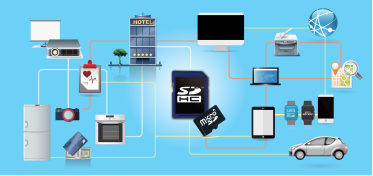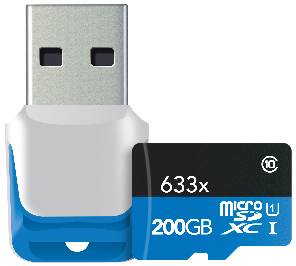When historians of the future look back on the top tech trends of 2017, certain technologies will likely stand out: blockchain, facial recognition, Internet of Things (IoT), autonomous vehicles and machine learning. However, those historians would be remiss to forget the ever-reliable microSD memory card.
Specified and standardized by the SD Association (SDA), microSD memory cards are continually improved and tested, and have been a major part of both consumer and industrial applications for many years.
Today, use cases for the fingertip-sized memory card stretch across a variety of well-known markets, including mobile phones, drones, automobiles and cameras. But what was once merely a consumer storage device is now an integral part of how a computer, car, IoT device or gadget operates.
This year saw a number of rising trends for SD and microSD memory card applications that are likely to have some definite staying power in 2018 and beyond.
1. The rise of IoT
The growing market for IoT technologies is a boon for memory cards.
Connected devices need more storage to manage large amounts of constantly streaming data. A practical solution to this problem is a microSD memory card, given its compact size and affordability. Low-power, data-capturing IoT devices also have small form factors, making low-power-consumption microSD memory cards an excellent fit.

2. SD memory cards in drones
microSD memory cards in unmanned aerial vehicle (UAV, or, more commonly, drone) applications are very popular. Every drone has a very small, low-powered computer connected to cameras and sensors; the sole reason the drone can fly at all is because the electronics inside are so light, making a drone a perfect fit for the tiny and rugged microSD memory card.
Emerging drone requirements for higher resolution, such as 8K, multiple sensor and 360-degree video capture, will drive the need for greater performance and capacity in removable storage. The SD Association’s new Video Speed Class specification will meet these requirements, because larger amounts of storage needed per drone flight will require higher speed and image quality.
3. SD memory cards in automobiles
SD memory cards not only satisfy automotive application storage needs, but also meet reliability and temperature-range requirements. They are optimized according to typical automotive requirements, where the number of accesses (especially in reading) and component lifetime must meet the needs of this rugged application.
As automobile manufacturers reach new technology milestones, reliable data storage is a necessity for every new car that hits the road today. In fact, a single self-driving car is expected to generate 4 TB of data each day, according to Intel. Today, automotive applications like GPS, mapping systems and other tools usually reside on some type of SD card.
4. microSD in emerging nations
The residents of emerging nations have witnessed more technological change in the previous 10 years than their developed counterparts experienced in the previous 30 years. The demand for data is exploding in these regions, as is a growing need for affordable, easily upgradeable and reliable storage in a small form factor.
Inexpensive and refurbished mobile phones continue to attract a growing number of users in developing nations to the Internet, with many bypassing computers entirely and going straight to mobile. These less-expensive mobile devices are equipped with microSD cards of various capacities and are the storage vehicle for many of these users.
5. SD memory cards in smartphones
microSD memory card accessibility remains valuable to mobile phone manufacturers. Customers demand a growing storage capability, especially with the growth of photo- and video-centric apps like Instagram, Snapchat, Netflix and other downloadable video services. Higher-resolution photos and video, as well as increasing file sizes, fuel a need for more device storage space. Smartphone users with a microSD slot can self-upgrade their storage in seconds at any time of the day and without buying a new phone. Plus, with the high cost of unlimited data plans, mobile phone users can utilize their microSD memory card to access offline data, rather than stream from the cloud.
Well-known brands offering Android smartphones continue to support microSD in their mobile phones. Indian consumer electronics maker Micromax aims to sell 6 million units of its budget-friendly Bharat smartphone series by March 2018 – with the latest phone in the series, the Bharat 5, costing about $86, Micromax is bringing more affordable smartphones to consumers.
6. Storage explosion
This year saw the introduction of a 400 GB microSDXC card that holds up to 40 hours of full-HD video and transfers to 1,200 photos per minute. In 2015, the world saw a record-breaking 200 GB microSDXC card. In 2016, a then-new 256 GB microSDXC card had such high capacity that no devices could support it.
What does this new high-water mark in storage capacity mean for 2018? Expect more storage, more speed and maybe even the arrival of a 500 GB microSDXC card.
7. Embedded computing
microSD cards are an integral part of embedded computing devices like Raspberry Pi, the market for which is continuing to expand as more users move away from traditional computers. These devices require a relatively high-performance microSD memory card as both boot and storage device; one of the highest-impact upgrades a user can make is buying a fast microSD memory card, especially for applications that require a lot of random reads and writes.
As users become more educated and ask more questions about performance, durability and specs, it’s clear that SD memory cards aren’t just a consumer storage device anymore, but are becoming an integral part of how a computer or device works.

8. Equal use in industrial and consumer markets
Buying tech products used to be comparatively easier than it is today. Now, every product category has such a wide selection and so many specs, users are required to learn about a product and be more selective to ensure they are getting the right product for their application.
SD and microSD memory cards are sometimes only thought of as consumer-grade storage devices, but the truth is that many industrial users also trust SD memory cards, including security camera companies and automobile manufacturers. Industrial-grade computer boards are growing in popularity, opening the cards up to a plethora of new applications that lend themselves more to the industrial space than the consumer arena.
Successful manufacturers will serve both markets by making cards that are fit for a range of uses and applications.
Looking Forward
One of the SD Association’s main goals is to democratize data storage. To meet this goal and ensure a bright future for SD and microSD memory cards, the SD Association will continue create new specifications and ensure manufacturers are appropriately responding to user needs.
We will see the trends of 2017 advance and new uses continuously arise in 2018 as well as in coming years. We can confidently say that as long as users need to store and access data on an easy-to-manage, ubiquitous and trusted form factor, there will always be a need for SD memory cards.
Paul Norbury is a SD Association board member and the chief executive of multi-award-winning company Cardwave, which has offices in Devizes, Wiltshire, U.K., and Dallas, Texas. Norbury can be reached at paul.norbury@cardwave.com.
© SD Association. All rights reserved. SD, SDHC, miniSDHC, microSDHC, SDXC and microSDXC Logos are trademarks of SD-3C LLC



